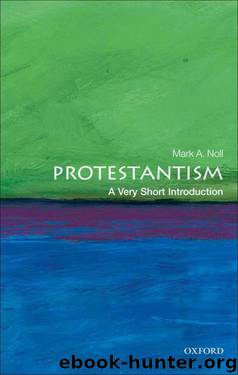Protestantism: A Very Short Introduction (Very Short Introductions) by Noll Mark A

Author:Noll, Mark A. [Noll, Mark A.]
Language: eng
Format: mobi, epub
Publisher: Oxford University Press
Published: 2011-08-24T16:00:00+00:00
Innovations
The channels through which Protestantism broke out of settled Western ways multiplied in the century after the Lutheran pietists left Germany. Hard on their heels came the Moravians. From a modern perspective, the Moravians were by far the most attractive early Protestant missionaries. They came very close to being apolitical; they were eager to learn native languages and learn about local cultures; they avoided colonizing violence; and they preached a gospel message stressing God’s love for all humans. Moravian missionaries began to stream out of Count von Zinzendorf’s estate in Saxony from 1732 onwards. Missionaries like David Nitschmann were soon at work among slaves in St Thomas of the Virgin Islands. David Zeisberger did similar work among the Delaware Indians in eastern Pennsylvania even as he helped to establish a Moravian settlement at Bethlehem in the same colony. Zinzendorf and his successor, August Gottlieb Spangenberg, trotted the globe to encourage missionaries, strengthen Moravian settlements, and raise money. Very soon, converts like Rebecca Protten, a slave on St Thomas who was eventually freed and later married a Moravian missionary, themselves became effective evangelists. Moravian successes were sometimes short-lived, due sometimes to their own failures (Zinzendorf was a notoriously poor administrator) and sometimes to circumstances beyond their control (like the attacks on peaceful Indian converts in Pennsylvania during the French and Indian, or Seven Years, Wars). Yet in their 18th-century labours and in the Moravian communities that exist to this day throughout the world, they have been among the Protestant missionaries who come closest to the high ideals of the Christian gospel.
Other Protestants of the era were also pushing hard against the boundaries of Christendom. They included the first converted slaves in North America to become active church leaders. Missionaries sponsored by the Anglican SPG and the Calvinistic Puritans of New England had made some largely ineffective attempts to evangelize enslaved African Americans. The first general interest in Christianity among North America’s growing slave population was not sparked, however, until the colonial Awakenings of the 1740s. Its leaders, like George Whitefield, did not attack the institution of slavery itself, but they did preach a message of spiritual liberation that attracted many converts.
Download
Protestantism: A Very Short Introduction (Very Short Introductions) by Noll Mark A.epub
This site does not store any files on its server. We only index and link to content provided by other sites. Please contact the content providers to delete copyright contents if any and email us, we'll remove relevant links or contents immediately.
| Buddhism | Christianity |
| Ethnic & Tribal | General |
| Hinduism | Islam |
| Judaism | New Age, Mythology & Occult |
| Religion, Politics & State |
Cecilia; Or, Memoirs of an Heiress — Volume 1 by Fanny Burney(31339)
Cecilia; Or, Memoirs of an Heiress — Volume 3 by Fanny Burney(30936)
Cecilia; Or, Memoirs of an Heiress — Volume 2 by Fanny Burney(30891)
The Secret History by Donna Tartt(16635)
Sapiens: A Brief History of Humankind by Yuval Noah Harari(13060)
Leonardo da Vinci by Walter Isaacson(11907)
The Radium Girls by Kate Moore(10910)
Sapiens by Yuval Noah Harari(4541)
The Wind in My Hair by Masih Alinejad(4426)
How Democracies Die by Steven Levitsky & Daniel Ziblatt(4401)
Homo Deus: A Brief History of Tomorrow by Yuval Noah Harari(4282)
Endurance: Shackleton's Incredible Voyage by Alfred Lansing(3845)
The Silk Roads by Peter Frankopan(3764)
Man's Search for Meaning by Viktor Frankl(3637)
Millionaire: The Philanderer, Gambler, and Duelist Who Invented Modern Finance by Janet Gleeson(3572)
The Rape of Nanking by Iris Chang(3518)
Hitler in Los Angeles by Steven J. Ross(3440)
The Motorcycle Diaries by Ernesto Che Guevara(3338)
Joan of Arc by Mary Gordon(3260)
